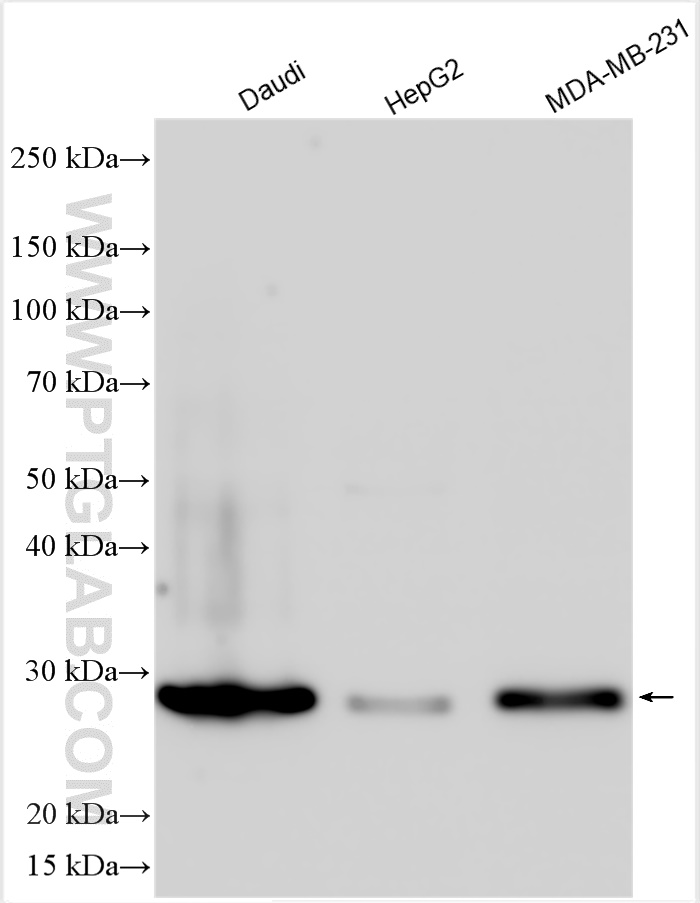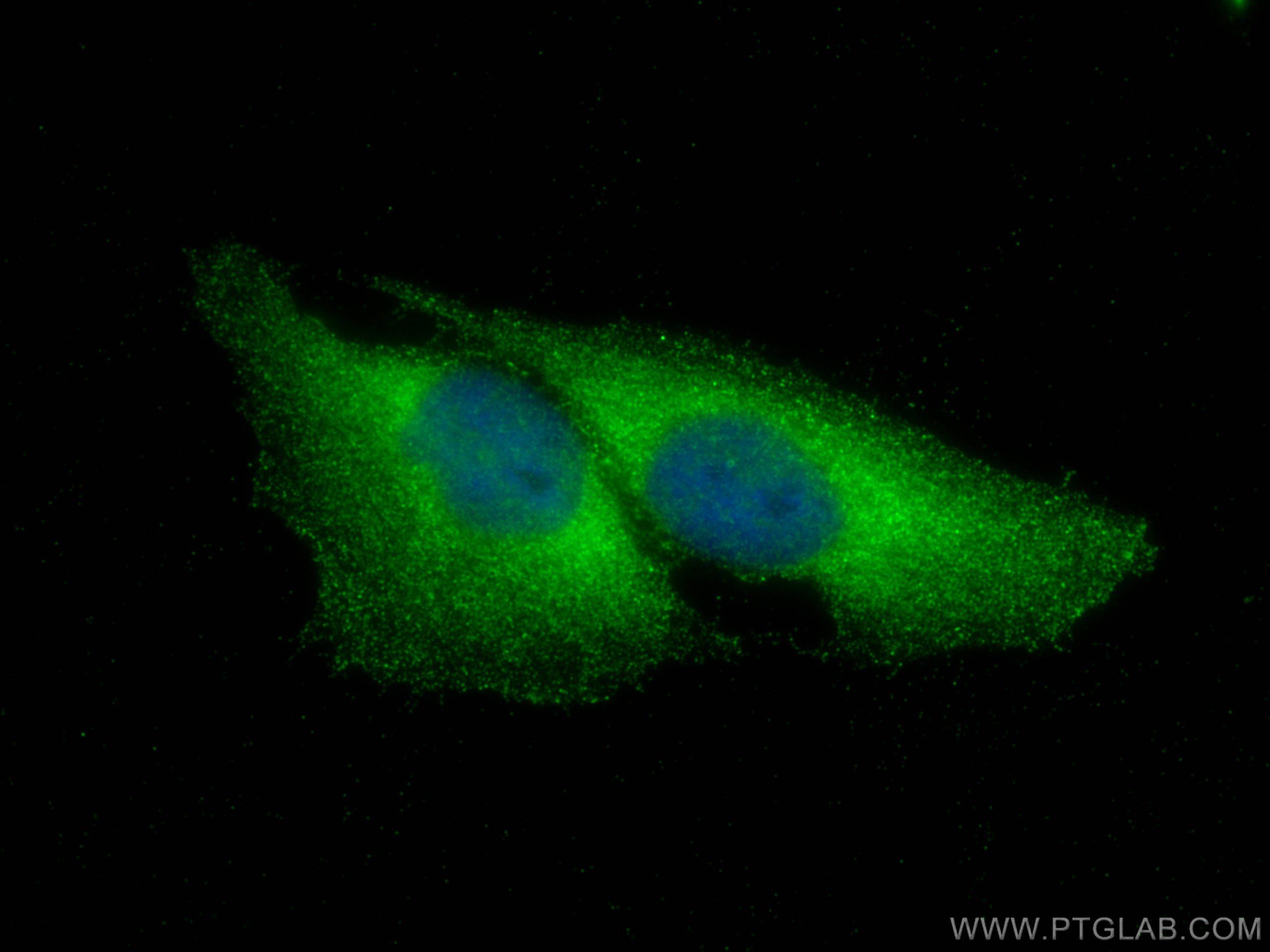验证数据展示
经过测试的应用
| Positive WB detected in | Daudi cells, HepG2 cells, MDA-MB-231 cells |
| Positive IHC detected in | human urothelial carcinoma tissue Note: suggested antigen retrieval with TE buffer pH 9.0; (*) Alternatively, antigen retrieval may be performed with citrate buffer pH 6.0 |
| Positive IF/ICC detected in | U2OS cells, HepG2 cells |
推荐稀释比
| 应用 | 推荐稀释比 |
|---|---|
| Western Blot (WB) | WB : 1:1000-1:6000 |
| Immunohistochemistry (IHC) | IHC : 1:50-1:500 |
| Immunofluorescence (IF)/ICC | IF/ICC : 1:200-1:800 |
| It is recommended that this reagent should be titrated in each testing system to obtain optimal results. | |
| Sample-dependent, Check data in validation data gallery. | |
产品信息
18040-1-AP targets Securin in WB, IHC, IF/ICC, IP, ELISA applications and shows reactivity with Human samples.
| 经测试应用 | WB, IHC, IF/ICC, ELISA Application Description |
| 文献引用应用 | WB, IHC, IF, IP |
| 经测试反应性 | Human |
| 文献引用反应性 | human, mouse |
| 免疫原 | Securin fusion protein Ag12670 种属同源性预测 |
| 宿主/亚型 | Rabbit / IgG |
| 抗体类别 | Polyclonal |
| 产品类型 | Antibody |
| 全称 | pituitary tumor-transforming 1 |
| 别名 | EAP1, Esp1 associated protein, HPTTG, pituitary tumor transforming 1, PTTG, PTTG1, Securin, Securin / PTTG1, Tumor transforming protein 1, TUTR1 |
| 计算分子量 | 202 aa, 22 kDa |
| 观测分子量 | 28 kDa |
| GenBank蛋白编号 | BC101834 |
| 基因名称 | Securin |
| Gene ID (NCBI) | 9232 |
| RRID | AB_2173410 |
| 偶联类型 | Unconjugated |
| 形式 | Liquid |
| 纯化方式 | Antigen affinity purification |
| UNIPROT ID | O95997 |
| 储存缓冲液 | PBS with 0.02% sodium azide and 50% glycerol , pH 7.3 |
| 储存条件 | Store at -20°C. Stable for one year after shipment. Aliquoting is unnecessary for -20oC storage. |
背景介绍
Securin, also known as the pituitary tumor transforming gene (PTTG1), was first isolated from rat pituitary tumor cells. Securin is a multi-functional protein that regulates sister chromatin segregation in mitosis, DNA repair, gene transcription, metabolism, and organ development. Securin is normally expressed in tissues with high proliferative activity, including the spleen, thymus gland, and testis, whereas it is rarely expressed in differentiated mature tissues (PMID: 22563433, PMID: 36123907). The calculated molecular weight of Securin is 22 kDa. With post-translational modification, the molecular weight of Securin will be migrated to 28 kDa.
实验方案
| Product Specific Protocols | |
|---|---|
| WB protocol for Securin antibody 18040-1-AP | Download protocol |
| IHC protocol for Securin antibody 18040-1-AP | Download protocol |
| IF protocol for Securin antibody 18040-1-AP | Download protocol |
| Standard Protocols | |
|---|---|
| Click here to view our Standard Protocols |
发表文章
| Species | Application | Title |
|---|---|---|
Front Immunol Identification and validation of tryptophan-related gene signatures to predict prognosis and immunotherapy response in lung adenocarcinoma reveals a critical role for PTTG1 | ||
Cell Mol Life Sci Microglial activation in an amyotrophic lateral sclerosis-like model caused by Ranbp2 loss and nucleocytoplasmic transport impairment in retinal ganglion neurons. | ||
Sci Rep APC/C(CDC20) and APC/C play pivotal roles in the process of embryonic development in Artemia sinica. | ||
Cell Cycle Chronic restraint stress disturbs meiotic resumption through APC/C-mediated cyclin B1 excessive degradation in mouse oocytes. | ||
Cryobiology Melatonin promotes in vitro maturation of vitrified-warmed mouse GV oocytes potentially by modulating MAD2 protein expression of SAC component through MTRs. | ||
Open Med (Wars) The Pseudogene PTTG3P Promotes Cell Migration and Invasion in Esophageal Squamous Cell Carcinoma.
|



